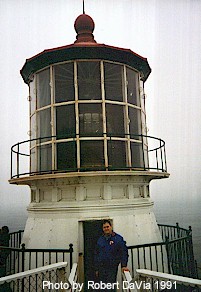

The Point Reyes Light is located on the Gulf of the Farallones, near Iverness, CA. It was established in 1870 and was automated in 1975. The cylindrical tower is white with a red roof. The tower height is 35 feet, with the height of its focal plane 294 feet above sea level.

The following is from a pamphlet obtained at the Point Reyes Lighthouse.
San
Francisco Chronicle 1887
Besides the well known use of lighthouses for warning ships of rocky shores and reefs, they also serve the important function of being navigational aids along the coast. Mariners can recognize each lighthouse by its unique flash pattern. There are many days along the coast when it is too foggy to see the lighthouse. This is when a fog signal becomes important. Like lighthouse, each fog signal has an identifying pattern for the mariner.
The combination of lighthouses and fog signals does not completely eliminate the tragedy of shipwrecks, however. In fact, 46 shipwrecks were recorded in the first 60 years after the Point Reyes Lighthouse was built. Because of this ongoing problem, a U.S. Life-Saving Station was established on the Great Beach just north of the lighthouse in 1890. Here, men walked the beaches in four hour shifts, warning ships offshore and looking for people who might need rescuing from the frigid waters and powerful undertows just off the shore.
This life-saving station was later moved into Drakes Bay by Chimney Rock and finally closed its doors in 1968. This National Historic Landmark remains and can be viewed at Chimney Rock Beach. The rocky promontory of the Point Reyes Headlands still claims ships to this day.
Meanwhile, the sheer granite of the Headlands had been blasted to clear a level area upon which the lighthouse could be erected. It took six weeks to move all the parts from the top of the cliff and construct the lighthouse some 300 feet below.
The experience of the Point Bonita Lighthouse just south of Point Reyes, proved invaluable in choosing this site since that lighthouse had to be moved down from its original location 22 years after being built. TO be effective, both lighthouses had to be situated below the characteristic “high fog” of the Bay Area. After many years of political pressure, tedious transportation and construction, the Point Reyes Light first shone on December 1, 1870.
Wind, fog and isolation made the Point Reyes Lighthouse an unpopular post for lightkeepers. One head keeper and three assistants worked around the clock in four six-hour shifts. One half-hour before sunset, a keeper would descend the stairs to light the oil lamps which illuminated the lighthouse. The wicks of these lamps required tending throughout the night, a job so time consuming that the keepers were nicknamed “wickies”.
The light was usually lit only between sunset and sunrise, however the routine maintenance of cleaning the lens, polishing the brass and stoking the steam-fired fog signal kept keepers busy throughout the day. At the end of his shift, the keeper would sometimes have to crawl back to his quarters, the winds being so strong that they would knock him over should he stand up.
The Point Reyes Lighthouse is equipped with a first order Fresnel (Fray-nel) lens. Augustine Jean Fresnel, a disenchanted road engineer, revolutionized the optical theories of his time with his new lens in 1822. These lenses came to be used the world over.
Before the conception of the Fresnel lens, lighthouses used a system of mirrors to reflect light out to sea. Since light scatters in all directions, more light was lost than was used where it was needed. The most effective lighthouses could only be seen 8-12 miles away.
The principle at work in Fresnel’s lens is to bend the light that would normally be scattered and to gather it into a concentrated wall of light which leaves the lighthouse on a horizontal plane. This bending or refraction is achieved by the calculated placement of 1,032 lead crystal prisms into a dome-shaped lens.
The Point Reyes Lighthouse Fresnel lens is divided into 24 vertical panels which break the light into 24 separate beams. The lens is made to turn by a 175-pound counterweight, and a series of gears similar, on a larger scale, to a grandfather clock. Turning the lens creates the flash pattern of one flash every five seconds.
The historic Point Reyes Lighthouse was in service for 105 years before being retired. During that time, it endured many hardships, not least of which was the 1906 earthquake. The Point Reyes Peninsula moved 18 feet that day and took along with it the Point Reyes Lighthouse. Though some damage was incurred, the light was repaired and in working order that night. Sixty-seven miles to the north, the Point Arena Lighthouse was so severely damaged that it was condemned, torn down, and later rebuilt.
The National Park Service is now responsible for the maintenance of the historic lighthouse at Point Reyes. It is still cleaned, polished and greased just as it was in days gone by. With this care, the light can be preserved for future generations – to teach them of maritime history and of the people who worked the lights, day in and day out, rain or shine.
The Lighthouse Visitor Center is open from 10:00 am to 5:00 pm, Thursday through Monday. The 300 steps leading down to the lighthouse are open, weather permitting, and 10:00 am to 4:30 pm, Thursday through Monday. When wind speeds exceed 40 M.P.H. the steps leading down to the lighthouse are closed for visitors’ safety. Tours of the lantern room and night lighting programs are available. Please call the Lighthouse Visitor Center for further details at (415) 669-1534
But at the heart of most visits is the allure of the
light station itself.
Return to the California Lights Page
Return to the: Alphabetical Listing or the Listing by States